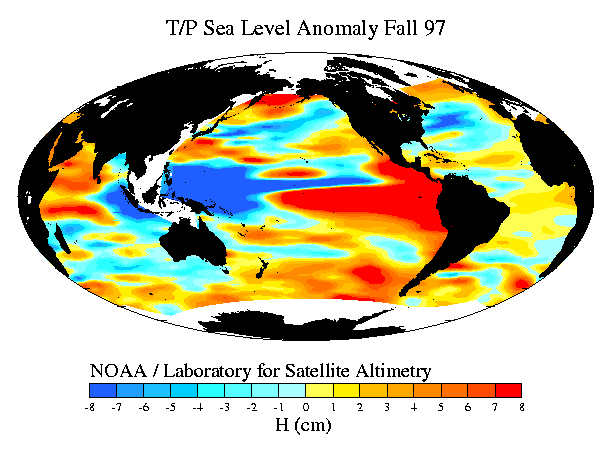
Central questions for our study of :
OCEANOGRAPHY
How does the ocean impact our everyday lives?
What are some methods we can use to study the ocean?
How do the oceans and the atmosphere interact?

Using satellite data of ocean height anomalies, we were able to uncover what other years in the 1990's were El Nino years. The image shown above indicates a strong El Nino since the Eastern Equatorial Pacific Ocean is much warmer than normal.
Common Oceanography Misconceptions
(However--any Newtown High School student can give you the scientifically accepted explanation)
MISCONCEPTION |
SCIENTIFICALLY ACCEPTED EXPLANATION |
| A tidal wave is the same thing as a Tsunami. | Tidal wave is NOT the correct term for a really large wave--that is a tsunami. A tidal wave is simply the movement of the tides in and out. |
| Spring tides only occur in the spring season. | Spring tides are higher than normal high tides and lower than normal low tides. They occur when the sun, earth, and moon are aligned (full or new moon) since the gravitational and inertial forces of the masses are constructively combined. |
| El Nino is only a weather phenomenon. | El Nino is actually an ocean and atmospheric phenomenon where the water in the Eastern Equatorial Pacific Ocean becomes warmer than normal. This extra heating causes the trade winds in the area to slow down (due to the changes in air pressure). The warm water will cause a change in the character of the air masses which develop in this area. As a result, warm moist air masses bring changes in weather patterns around the world. |
| The green ocean water found in the Mid Latitudes is unhealthy. | Green ocean water is an indicator that phytoplankton are present in the water. This is a sign that the water is quite healthy since the phytoplankton are a vital component of the oceanic food web. Without the green water (phytoplankton) many larger oceanic organisms would have no food supply, and thus not be able to survive. |